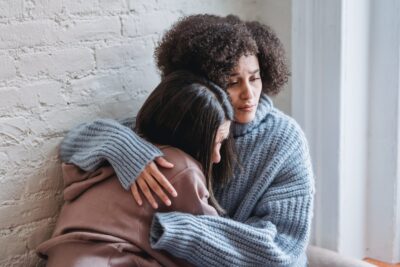Trauma-informed practices in higher education: Building support communities from the top down
Joanna Krueger
Associate Professor of Chemistry, UNC Charlotte
The views and opinions expressed are those of the author and do not necessarily represent the views or opinions of EAB.
The problem: Faculty and students alike are dealing with massive and varied post-traumatic stress issues due to the increase in gun violence on our campuses, the COVID-19 shutdown, and an increasingly divisive political environment.
A solution: Build support communities among faculty that model inclusive, consensus-building learning environments and model teaching and learning using trauma-informed evidence-based practices. UNC Charlotte, for example, has the Active Learning Academy, which brings in speakers and offers internal education opportunities as well as a STEM Academy, which models evidenced-based practices in a fun, informative way and even pays participants a small stipend.
Being included and a valuable member of a team is an essential element for any healthy relationship. During a breakout activity on the February 7, 2023 EAB Rising Higher Education Leaders session, “The Hidden Enemies of Strategy: Five Mindsets to Defeat Incrementalism”, we used Edward de Bono’s Six Thinking Hats to practice mitigating higher education’s most common cognitive bias—the Paradox of Participation. We were informed of six modes of behavior and thinking, each given their own hat color.
We were to use this framework by identifying our typical thinking style and then choosing a different style to role-play a given scenario. My typical hat was “red” as I tend to react from my gut, using intuition, hunches and impressions to acknowledge the hidden emotions that affect every conversation and decision.
What was informative in this exercise is that the man who was role-playing my hat admitted that he was very uncomfortable playing that role and everyone agreed that emotions and feelings are often the first to be shut down when a committee is pressed for time to decide as to which new platform to implement. What I recognized is that if we were operating as a team, with the intent to build consensus, the silenced red hat voice might just provide the valuable insight and direction needed to avoid unnecessary or expensive, unproductive decisions.
-
Interested in the Rising Higher Education Leaders Fellowship?
Learn more about the program and future cohorts.
Project Overview
My EAB capstone project was to examine evidence-based educational pedagogies and practices currently implemented in universities across the nation for dealing with globally traumatized student populations, such as those that the pandemic shutdown and the increase in campus gun violence incidents have produced. Not surprising (to me anyway) was that implementation of some form of active, participatory learning in the classroom was almost always recommended.
For example, faculty from UC Merced note that “teaching requires developing a safe and flexible learning environment and in times of crisis, this learning environment must be resilient.” In this article, they provide a myriad of evidence-based teaching practices that encourage flexible approaches to learning without compromising on rigor. And several faculty from diverse institutions across the country collaborated in a 2020 article to report that the “rapid shift to online teaching in 2020 meant teaching in panic mode.”
They advocate for active and inclusive teaching practices to help students feel more connected to their learning, to their peers, and ultimately to their campus. Active learning strategies:
- Enable thinking and doing in the present moment
- Encourage collaboration over competition and
- Build inclusive communities.
This knowledge has been argued for over a decade now and is supported by evidence and data published in the peer-reviewed literature, some of which could be argued that if the experiments analyzed had been conducted as randomized controlled trials of medical interventions, they may have been stopped for the benefit. Meaning that the control condition might be discontinued because the treatment being tested was clearly more beneficial.
What is new is that these same strategies are also key to engaging a withdrawn, traumatized student population and building a supportive, resilient community-based learning environment. Utilization and modeling of these effective, participatory learning activities among faculty groups are also a way to build community among faculty as they are “trained” to be effective trauma-informed instructors.
Community and collaboration will heal our post-traumatic brains and build resiliency that will trickle down to the students via effective modeling behavior. Connected faculty will build connected students who will become connected alumni and that is good for the bottom line.
Looking to UNC Charlotte
UNC Charlotte has already set the stage for building community among teaching faculty through the center for teaching and learning, the active learning community, and the STEM academy. My recommendation would be to continue to support these fledgling communities, celebrate them and encourage their growth recognizing that there exists serious barriers and lack of motivation to implement such change, particularly among the tenure-track faculty.
Back in 2014, while on an NSF panel, I had heard about evidence-based teaching practices and began scouring the literature and initiating a self-motivated, voluntary change in my own classroom. This research, and trial and error practice, connected me to a teaching faculty member and led to my joining the active learning POGIL community, attending summer faculty development workshops, and to my joining the newly formed Active Learning Community (ALC) spearheaded by the Center for Teaching and Learning (CTL) and a STEM academy that meets once a month to read and to share the current teaching literature while the facilitators model different “active learning” tools. We also attend AAC&U STEM conferences together and have built a real friendship.
I can confidently share that having made the transition to active learning pedagogies and connections to these teaching communities made my transition to online teaching that much smoother and more effective. I have an enormous amount of gratitude for that connection and that community. But many of my colleagues found themselves struggling to shift, and most of those that didn’t have the tools in place to learn and implement new teaching strategies, bought time off, left, or retired.
In 2019, EAB put together a “Building trauma-sensitive schools” handout that includes information from the U.S. Department of Education National Center on Safe Supportive Learning Environments; EAB interviews, and analysis from the “Supporting Students with a History of Trauma” report. This handout encourages training and supporting faculty in a trauma-informed way and allowed me to see how valuable my ALC and STEM community groups had been in making me more resilient throughout the school shooting incident of spring 2019 and again during the rapid, panicky transition to online instruction the following the pandemic shutdown in spring of 2020.
The problem is that we are all now dealing with post-traumatic stress. It is no longer just personal, family, and generational trauma. The active shooter on campus in the spring of 2019 not only took lives but disrupted the community (and even our beautiful scale-up active learning classroom). The effects of the COVID-19 shutdown and divisive political environments have all increased our collective uncertainty and fear. We can no longer go back to pre-pandemic practices. They simply won’t work.
Everyone, both faculty and students, has in some way suffered trauma or multiple micro-traumatic events. Denial and continuing to lecture as if nothing has changed simply will not work for much longer and certainly will not build that community that will lead to happy, connected alumni.
In summary, the three-fold evidence-based teaching practices that encourage flexible approaches to learning for students are the same that can be applied in supported faculty communities to encourage sharing of new, inclusive approaches to teaching:
- Reduce cognitive load by eliminating extraneous material and organizing the content with clear learning objectives and a roadmap
- Rethink assessments, focusing on learning and critical thinking and providing choice and
- Use trauma-informed teaching practices that create community, encourage collaboration over competition, and use teamwork to build consensus.
At the beginning of each semester, I have been telling my students that they will be working in teams, not groups. I then clarified that a team values every voice and works collaboratively to build consensus whereas a group often works independently on their individual contributions to complete a project. They often tell me that although they have always hated group work, they really enjoyed teamwork.
More Blogs

How to avoid one of the most common pitfalls when navigating the aftermath of student death

How 3 institutions successfully raised funds for student mental health support
